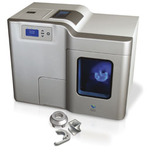![The OpenAstroTracker [Source: Thingiverse]](https://fabbaloo.com/wp-content/uploads/2020/05/image-asset_img_5eb065cbce4f5.jpg)
The OpenAstroTracker [Source: Thingiverse]
This week’s selection is the OpenAstroTracker by Fabian Uehleke.
Fabian Uehleke is a Germany-based astrophotographer who has designed a 3D printable tracking mount.
What’s a tracking mount? In the complex world of astrophotography, the game is to ensure a camera can be accurately pointed at a selected large in the sky and hold that position without drifting or wobbling for long periods of time.
The long periods are required because often the targets are quite dim and thus require very long exposures, sometimes measured in minutes. If a mount were not providing a stable view, the images captured would be terribly smeared.
Imagine “zoomed in” to a distant planet or star, and consider that the slightest wobble would jiggle your view significantly. That shows how precise a tracking mount must be.
It’s entirely possible to purchase commercial tracking mounts, and indeed you can spend absurd amounts of money on them if you wish. The more money you spend, the more accurate and able to handle heavier cameras (telescopes) you can go.
But Uehleke offers an alternative: build your own tracking mount. There are a number of 3D printed parts, as well as some mechanical, electrical and metal components required. However, these in total will cost you less than a commercial tracking mount, so it may be a good project for someone with appropriate build skills and time to do so.
There are some limitations, however, as there are with any tracking mount, including commercial ones. The OpenAstrotracker is able to handle only DSLR cameras. It is not strong enough to handle an actual telescope. However, Uehleke says you should be able to use up to a 300mm lens on the DSLR with success.
Tracking mounts must compensate for the rotation of the Earth, which results in different sky motion depending on where you are located. Thus tracking mounts are often designed to work with certain latitudes. The OpenAstroTracker is designed to work within 15 – 55 degrees north latitude only. If you happen to be outside that range, you may have to make modifications to the OpenAstroTracker design.
If you desire an inexpensive way to get into astrophotography, this may be a way to start, particularly if you already have a DSLR handy. But be warned, once you catch the astrophotography bug, you might not escape. It’s a pretty expensive hobby; I know this from personal experience.
Via Thingiverse

